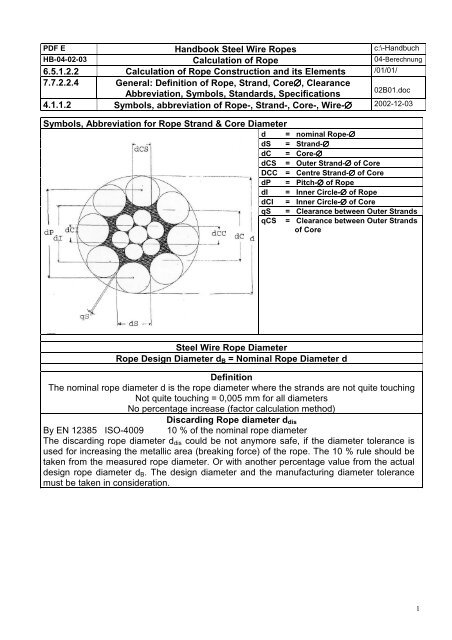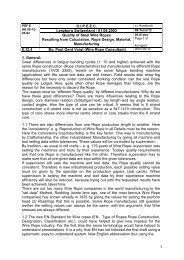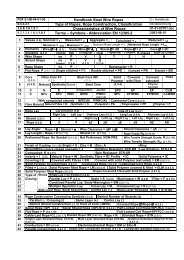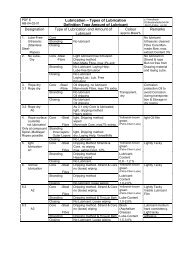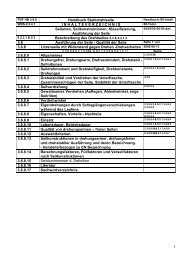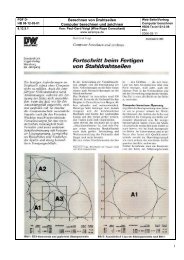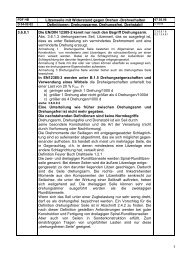E-HB-04-02-03 Definition Rope Diameter
E-HB-04-02-03 Definition Rope Diameter
E-HB-04-02-03 Definition Rope Diameter
You also want an ePaper? Increase the reach of your titles
YUMPU automatically turns print PDFs into web optimized ePapers that Google loves.
PDF E Handbook Steel Wire <strong>Rope</strong>s c:\-Handbuch<br />
<strong>HB</strong>-<strong>04</strong>-<strong>02</strong>-<strong>03</strong> Calculation of <strong>Rope</strong> <strong>04</strong>-Berechnung<br />
6.5.1.2.2 Calculation of <strong>Rope</strong> Construction and its Elements /01/01/<br />
7.7.2.2.4 General: <strong>Definition</strong> of <strong>Rope</strong>, Strand, Core∅, Clearance<br />
Abbreviation, Symbols, Standards, Specifications<br />
<strong>02</strong>B01.doc<br />
4.1.1.2 Symbols, abbreviation of <strong>Rope</strong>-, Strand-, Core-, Wire-∅ 20<strong>02</strong>-12-<strong>03</strong><br />
Symbols, Abbreviation for <strong>Rope</strong> Strand & Core <strong>Diameter</strong><br />
d = nominal <strong>Rope</strong>-∅<br />
dS = Strand-∅<br />
dC = Core-∅<br />
dCS = Outer Strand-∅ of Core<br />
DCC = Centre Strand-∅ of Core<br />
dP = Pitch-∅ of <strong>Rope</strong><br />
dI = Inner Circle-∅ of <strong>Rope</strong><br />
dCI = Inner Circle-∅ of Core<br />
qS = Clearance between Outer Strands<br />
qCS = Clearance between Outer Strands<br />
of Core<br />
Steel Wire <strong>Rope</strong> <strong>Diameter</strong><br />
<strong>Rope</strong> Design <strong>Diameter</strong> dB = Nominal <strong>Rope</strong> <strong>Diameter</strong> d<br />
<strong>Definition</strong><br />
The nominal rope diameter d is the rope diameter where the strands are not quite touching<br />
Not quite touching = 0,005 mm for all diameters<br />
No percentage increase (factor calculation method)<br />
Discarding <strong>Rope</strong> diameter ddis<br />
By EN 12385 ISO-4009 10 % of the nominal rope diameter<br />
The discarding rope diameter ddis could be not anymore safe, if the diameter tolerance is<br />
used for increasing the metallic area (breaking force) of the rope. The 10 % rule should be<br />
taken from the measured rope diameter. Or with another percentage value from the actual<br />
design rope diameter dB. The design diameter and the manufacturing diameter tolerance<br />
must be taken in consideration.<br />
1
Handbook/<strong>04</strong>-Berechnung/01/01/<strong>02</strong>B01doc/Dat. 11.<strong>02</strong>.06/Seite 2 von 2<br />
From measured <strong>Rope</strong> diameter dm (actual) or nominal <strong>Rope</strong> diameter d<br />
7.7.2.2.4 Design <strong>Rope</strong> <strong>Diameter</strong> dB = Nominal <strong>Rope</strong> diameter d<br />
Example:<br />
Nominal <strong>Rope</strong> <strong>Diameter</strong><br />
10 mm<br />
Fibre Core Steel Core<br />
6-strand <strong>Rope</strong> 8-strand <strong>Rope</strong> Rotation<br />
Resistant<br />
<strong>Rope</strong> diameter<br />
% mm % mm % mm % mm<br />
1 2 3 4 5 6 7 8 9<br />
Manufacturing Tolerance = dm 1) +4,5 10,45 + 2,5 10,25 + 2 10,20 +1,5 10,15<br />
Critical <strong>Rope</strong> <strong>Diameter</strong> dcrit<br />
Regular Lay - 5% of dB - 5 9,50 - 5 9,50 - 5 9,50 4 9,60<br />
Lang Lay – 3 % of dB - 3 9,70 - 3 9,70 - 3 9,70 2,5 9,75<br />
Total reduction from measured<br />
rope diameter dm<br />
- Ordinary Lay from dm - 9,5 9,46 - 7,5 9,48 7,0 9,49 5,5 9,59<br />
- Lang Lay from dm - 7,5 9,67 - 5,5 9,69 5,0 9,69 4,0 9,74<br />
Discarding <strong>Rope</strong> Ø 10 % of d 9,00 9,00 9,00 9,00<br />
1) is also the value for the setting of the rope. (nominal rope-Ø if the strands are not quite touching.<br />
7.7.2.2.4 Design <strong>Rope</strong> <strong>Diameter</strong> dB = Nominal <strong>Rope</strong> diameter d<br />
Nominal rope diameter 10 mm Fibre Core Steel Core<br />
Example:<br />
Nominal <strong>Rope</strong> <strong>Diameter</strong> + 2,5%<br />
DB =10 mm + 0,25 = 10,25 mm<br />
6-strand <strong>Rope</strong> 8-strand <strong>Rope</strong> Rotation<br />
Resistant<br />
<strong>Rope</strong> diameter<br />
% mm % mm % mm % mm<br />
1 2 3 4 5 6 7 8 9<br />
Manufacturing Tolerance = dm 1) +2,5 2) 10,50 + 2,5 10,50 + 2 10,40 +1,5 10,40<br />
Critical <strong>Rope</strong> <strong>Diameter</strong> dcrit<br />
Regular Lay - 5% of dB 10,25 - 5 9,74 - 5 9,74 - 5 9,74 4 9,84<br />
Lang Lay – 3 % of dB - 3 9,94 - 3 9,94 - 3 9,94 2,5 9,94<br />
Total reduction from measured<br />
rope diameter dm<br />
- Ordinary Lay from dm - 10 9,45 - 10 9,45 9,5 9,41 8 9,57<br />
- Lang Lay from dm - 8 9,66 - 8 9,66 8,5 9,52 6,5 9,72<br />
Discarding <strong>Rope</strong> Ø 10 % of d 10 9,10 10 9,10 10 9,10 10 9,10<br />
1) is also the value for the setting of the rope. (nominal rope-Ø if the strands are not quite touching.<br />
2) Total Tolerance is only 5 % if already 2,5 % is taken for the design diameter only 2,5 % is left for<br />
the manufacturing tolerance. This could be not enough for a fibre core rope.<br />
3) Relating the 10 % from nominal rope diameter to design diameter the tolerance would be 11.2 %<br />
By this assumption the discarding rope diameter<br />
should be -- % of the new unused rope diameter dm:<br />
Ordinary lay Lang lay<br />
6 strand fibre core ropes 10 % 7.5 %<br />
6 strand steel core ropes 7,5 % 5,5 %<br />
8 strand steel core ropes 7,0 % 5,0 %<br />
Rotation Resistant <strong>Rope</strong>s 5,5 % 1) 4,0 % 1)<br />
1) might be different for different speciality rope<br />
constructions. Depending on crossing of wires per layer<br />
and Lay Directions, Crossing angles.


